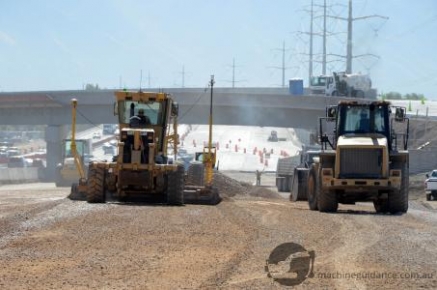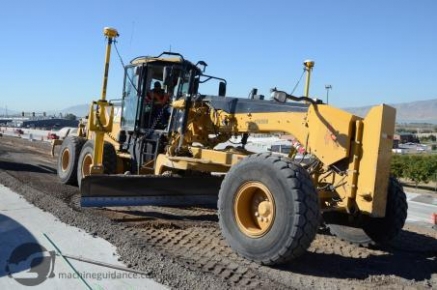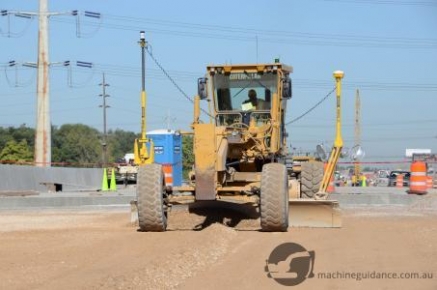Impressive Project - Impressive Technology
Charged with the design and build of a massive $US billion highway, the project decided to employ the use of the latest machine guidance technologies including a centralised data management system for wireless access to the 80+ GPS devices site-wide.Published: August 2013
Author: Jeff Winke

Intro
The quantity numbers on the billion-dollar project are staggering. Here are a few:
Roadway excavation = 1,500,000 cubic meters
Aggregates / sand = 9,000,000 tons
Concrete paving = 2,300,000 square meters
Asphalt paving = 3,150,000 square meters
Structural steel = 12,000,000 tons
The project is the expansion and reconstruction of 38.5 kilometers of the I-15 highway in Utah County, USA - the equivalent of 700 lane kilometers. Included in the job are 106 lane kilometers of cross street improvements, the rebuilds or replacements of 10 interchanges, 63 new or modified bridges, 12 temporary bridges, retaining and noise walls, and all the drainage / utility / electrical support for the finished interstate road.
The I-15 Corridor Expansion (I-15 CORE) project began in April 2010 and is earmarked for an end of 2012 completion - an unprecedented 35 month schedule. A joint venture company, called Provo River Constructors (PRC), was selected by the Utah Department of Transportation (UDOT) to design and build the I-15 CORE. PRC is led by Fluor Company, Dallas, Texas; Ames Construction Company, Minneapolis, Minnesota; Ralph L. Wadsworth Construction Company, Draper, Utah; Wadsworth Brothers Construction Company, Draper, Utah; and includes at least 30 other subcontractors.
"This design-build project is massive ... requires 1,500 workers, and we're using the latest technology throughout," states Scott MacKenzie, survey manager for PRC. "We probably have the largest number of Trimble systems in use at one jobsite in the world."
2
"We're using Trimble survey equipment to collect site data, Trimble software to create the site plan digital model, Trimble GCS900 Grade Control Systems on all of our blades and dozers, and Trimble PCS900 Paving Control Systems for all the finished paving," says Jarred Rico, assistant survey manager for PRC. "The technology is invaluable on a project like this. We're more efficient, productive, and managing a safer worksite."
According to the PRC managers, the technology is helping them stay ahead of schedule. "Our crews are working 24/7 to meet the tight schedule we have," MacKenzie says. "There is no good manual way to accomplish everything we're doing on this project. We're very happy with the systems and can't imagine working without them on this project."
PRC built the digital model from all of the job site and design data collected at the site. "Fortunately the technology allows us to build and adjust the digital model as we progress along the route," states MacKenzie. "We encounter soil changes, differing community standards from city to city, and a lot of conditions that weren't on the plans, so we have to survey and send the changes into the model builders for the most current plan that we work from."
Over the years much of the existing road had been resurfaced multiple times. They wouldn't use a profile, but would mill an inch or so off the existing road and then add a lift of fresh asphalt. This road is heavily used so UDOT determined that I-15 needed to be reconstructed and widened. When completed, the freeway will have up to six travel lanes in each direction, plus on-ramps and exit lanes. The inside and outside shoulders will be generous concrete-paved emergency shoulders. "This will be a big highway," Rico says.
In building the road, PRC first laid an average of 300mm of select granular borrow or crushed stone aggregate, which needed to be imported to the site. Then 150mm of smaller, open graded base was placed on top. Since the subbase had been graded with a motor grader using a Trimble GCS900 Grade Control System, PRC felt confident it could accurately place the gravel layers.

Left image

Right Image
End
On top of the gravel subbases, PRC then placed a 75mm layer of a lean mixture of hot mix asphalt (HMA) using a pair of pavers equipped with Trimble PCS900 Paving Control Systems to pave 7m wide strips.
"Because we used machine control paving systems on the asphalt base, we not only ensured that we used the proper amount of HMA, but we also saved on concrete yields because the concrete use is a direct reflection of the thickness, quality and consistency of the asphalt," states Rico. "Not having to use wire line, just for starters, saves a lot of labor, accidents, and rewiring. Plus, there's a higher level of confidence using the technology."
Using the machine guidance systems also allowed PRC to monitor and document its progress. The company checks its work every 3m to ensure quality.
"Our production is faster and our end-result quality is better," MacKenzie says. "As long as the system and paver are running right and we maintain the confirmation checks, we can complete whole sections and not have to do any grinds."
The project calls for placing anywhere from 260mm to 320mm of concrete. UDOT required PRC to stand behind the wearability of this heavily-traveled road. PRC will be issuing a four-year-warranty.
With a massive and complex project such as I-15 CORE, communication is critical. Errors not only can be costly, but they can eat up time.
"We're using the Trimble Connected Community, which is a web-based service that allows us to communicate in real time with our people and machines on the site," says Rico. "I can literally sit at a desk somewhere and make changes to the digital site plan and send it out to everyone on the site. It eliminates the cost and time of driving out to the jobsite, and locating every rod, total station, and machine to plug in a change."
Connected Community is a centralized information management system designed to wirelessly connect people, sites, and devices in real time. It provides a two-way data synchronization backbone.
"I-15 CORE is a custom design project so there are changes and adjustments that need to be made at all times," MacKenzie states. "It would be a nightmare to have to function without the Connected Community - when you think of trying to manually trying to get changes out to 80-some GPS machine systems and data collectors on the site, we wouldn't be as far along as we are."
MacKenzie comments that he's quite satisfied that the project is moving ahead quickly and will meet its aggressive timeline. "My number one concern all along is safety," states MacKenzie. "The project has been very safe and being able to use the automation that Trimble provides helps keep workers off the grade and out of harm's way."
"Also," Rico adds, "when you look at the volume of information collected, processed, and relied on every day, we wouldn't be able to produce the level of quality as quickly as we have without the help of technology."
When the last of the 2.3 million square meters of concrete paving is placed as the wear surface there will likely be plenty to celebrate.
Source Credit
Jeff Winke is a business and construction writer based in Milwaukee, Wis, USA. He can be reached through www.jeffwinke.com.
Return to Articles

